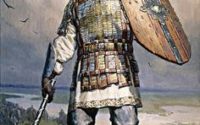The Jewish community of Alaska grew and developed together with the development of the oil industry. Alaska, with about 2,000-2,500 civilian Jews, has the most widely dispersed Jewish population of any of the 50 states of the U.S. more than half the Jews live in the two largest cities, Fairbanks and Anchorage. The latter has the only civilian congregation, Beth Shalom (Reform), which was organized in 1958.
In the 1850s and 1860s San Francisco Jews had developed extensive commercial ties with the Russian-American company in Alaska and many Jewish fur traders regularly visited there. Shortly after the United States purchased Alaska from Russia in 1867, Jewish traders, miners, fur dealers, and merchants arrived from San Francisco to probe the new territory. The gold rush in 1897 caused a number of Jewish fortune hunters and businessmen to immigrate to the territory, and in 1904 they organized a short-lived congregation. The cemetery they acquired in 1905 in Fairbanks is still the only Jewish burial ground in Alaska.
The first permanent Jewish settlers were Mr. And Mrs. Robert Goldstein who came to Juneau in 1885. Toward the end of the 19th century the Jewish lawyer Charles Rosner and his family, together with a few dozen other jews, settled at dawson. They established the Klondike community. In 1998, on the occasion of the centennial of the gold rush, the « Beth Haim » cemetery, which in the past served this community, was repaired.
In 1900, when the deposits of gold were discovered at Nome, the Rosen family, together with other Jews, moved to Nome and established there a community. The family of the Jew Max Hirschberg had already been there from the previous year. He had traveled all the way from Dawson, a distance of over 1,600 kms, on a bicycle. The Rosh Hashanah, new year of 1900, was celebrated at Nome by some 60 Jews, most of them refugees from Europe. They had a scroll of the Torah which they had brought from Europe.
Since then Jews have been prominent in the political life of the territory. They have served as mayors of many communities, and three Alaskan mountain peaks – mt. Ripinski, mt. Neuberger and mt. Applebaum – are named for prominent Jews. The Gerstle river, in northeast Alaska, is named for Lewis Gerstle, a San Francisco merchant whose Alaska commercial company popularized the use of sealskins, developed steamboat transportation, and financed some of Alaska’s first mining ventures. The famous Klondike gold discovery of 1897 was touched off when one of Gerstle’s steamers docked in San Francisco with $ 750,000 in gold aboard.
The Alaska commercial company’s line of river boats between Nome and Dawson on the Yukon River carried thousands of goldseekers and tons of their supplies. The development of trade by means of river boats retarded the growth of Nome, whose trade was carried mostly by sea. With time the population of Nome dwindled, and so did also the number of the Jews at Nome.
At the beginning of the 20th century Alaska had barely more than 100 Jews and no organized Jewish community or religious life to serve the handful of merchants, government employees, engineers, canners, fishermen, and scientists.
When Anchorage was established in 1915, a Jew by the name of Jacob Gottstein was also among the early settlers. He founded trade and storage companies. His commercial concern, J.B. Gottstein Company, was at the end of the century one of the largest private employers in Alaska. The first mayor of Anchorage was a member of the Jewish community, David Leopold.
The Jewish military chaplains who arrived in 1941 during World War II were the first rabbis to officiate in Alaska. The permanent civilian Jewish community grew out of the Fairbanks and Anchorage armed services committee when discharged servicemen, as well as homesteaders and government personnel, began coming in substantial numbers. When Alaska became the 49th state in 1958, Ernest Gruening, a former territorial governor, was elected one of her first two United States senators. In 1964 Jay A. Rabinowitz was appointed to the Alaska Supreme Court.
In 1988 the Reform community of Anchorage built its second synagogue. Side by side with the Reform community there was also a small orthodox community at anchorage, « Shomrei Or ». Small Jewish communities existed also in Juneau and in Fairbanks. In fact, Jews were living in all the urban settlements of the state.
In July 2000 Nome celebrated its Hebrew congregation centennial. Only one Jew was living in 2000 at Nome, but on 19th of July a prayer was held to commemorate the past Jewish community of Nome.
In Juneau, the Reform Juneau Jewish community (JJC) operates in public locations and members’ homes. In 2004, the congregation purchased a former community center to serve as the home of a future synagogue and Jewish school.



